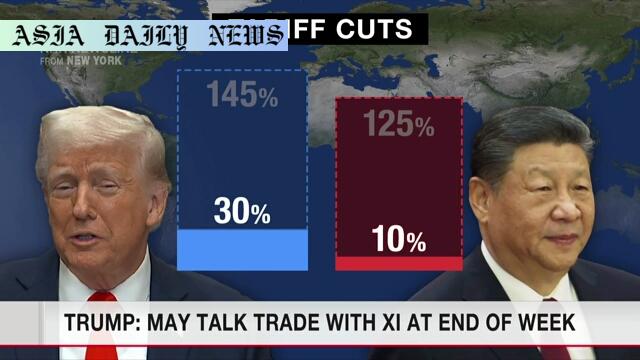Tariffs: The US and China agree to cut levies significantly for 90 days, signaling positive momentum in trade negotiations.
- US and China agree to slash tariffs on imported goods for 90 days.
- US cuts Chinese import tariffs from 145% to 30%, China drops US levies to 10%.
- President Trump might discuss tariffs further with Xi Jinping at the week’s end.
- Despite progress, future deals depend on tackling unresolved key issues.

Breakthrough in US-China Trade Negotiations
The escalating trade tensions between the United States and China have marked global economic uncertainty for the past several years. However, the tides seem to be turning, as both nations agreed to a temporary reprieve by significantly reducing tariffs on each other’s goods. Following trade discussions in Geneva over the weekend, the two economic giants announced a landmark agreement to scale back tariffs in place for a period of 90 days. The United States made a considerable step forward, reducing levies on Chinese goods from a staggering 145% to just 30%. In return, China lowered its tariffs on American imports from 125% to a modest 10%. This pivotal decision appears to signal a willingness from both parties to lessen tensions and seek collaborative solutions.
The Core Issues Beneath the Tariff Reduction
While the tariff reduction is a monumental step, it only scratches the surface of deeper economic concerns. President Donald Trump emphasized the importance of achieving a more equitable trade relationship, pointing out the historical asymmetry between US market access to China and China’s access to the US. As Trump stated, “We opened our country to China, and they didn’t open their country to us.” One of the primary goals of these negotiations is to enable fairer market access for American businesses and reduce the overall US trade deficit. However, resolving such systemic challenges requires time, intricate discussions, and mutual trust, which remain open ends in the current negotiations.
Trump-Xi Discussion: A Crucial Step Forward
A potentially game-changing development could arise if President Trump follows through on his intention to speak directly with Chinese President Xi Jinping later this week. Direct dialogue between the top leaders often propels negotiations forward and sets a tone of cooperation. For now, both sides are committed to the significant progress made over the weekend, but Trump warned that the current 90-day grace period might serve as only a temporary breakthrough. Trump’s remarks on possibly reinstating higher tariffs if talks reach an impasse highlight the fragility of the situation.
The Challenges of the 90-Day Window
The 90-day period might seem insufficient to address the core issues at hand comprehensively. Key US demands such as enhanced market access, intellectual property protection, and reducing the massive US trade deficit are hurdles that require long-term solutions. Additionally, structural reforms within China’s economic and political framework to accommodate fair trade practices remain a contentious issue that might clash with Beijing’s goals. Given the complexities involved, both sides need to work diligently, leveraging the temporary break in levies to focus on broader, lasting solutions.
The Global Implications of US-China Tariff Cuts
The outcome of these negotiations matters not just to the United States and China but also to the global economy. The prolonged trade war has disrupted supply chains, increased manufacturing costs, and rattled investors worldwide. This temporary truce will bring some stability and the potential for optimism in the markets. However, global players remain watchful, knowing that uncertainty could resurface if talks collapse or if anticipated breakthroughs do not materialize within the stipulated timeframe.



Commentary
The Importance of US-China Collaboration
The announcement of tariff reductions between the US and China is a refreshing development in what has otherwise been a strained economic relationship. Both sides stepping back from the brink can reignite hope for resolution to the trade war that has caused disruptions globally. However, this cautious optimism must be tempered by an understanding of the underlying complexities that still need to be addressed. Nonetheless, it is encouraging to see both governments realizing the adverse impacts of their prolonged standoff and taking proactive measures toward reconciliation.
Temporary Progress, Larger Concerns
While the immediate benefits of these tariff cuts bring relief, the root causes of the trade war remain unresolved. The US’s demand for better market access and a reduction in the trade deficit are not concerns that can be addressed within a 90-day framework. China’s readiness to implement deep structural reforms necessary to comply with these demands is still uncertain. These challenges could strain the dialogue in the coming months and potentially undo recent gains. Without a clear roadmap for addressing fundamental differences, the pathway to sustained economic harmony remains uncertain.
A Tangible Step Forward but With Fragile Trust
Beyond the economic implications, this latest development highlights the crucial role of diplomacy in easing global tensions. The potential phone discussion between President Trump and President Xi at the end of the week could further pave the way for meaningful breakthroughs, but mistrust continues to shadow these engagements. Both countries need to commit to transparency, mutual benefits, and compromise to ensure that this is more than a fleeting gesture of goodwill. The world is watching as these two economic powers take steps to define the future of trade relations.